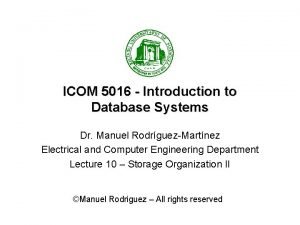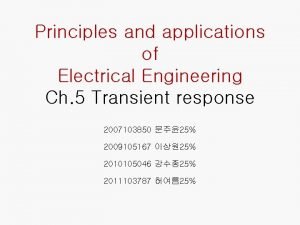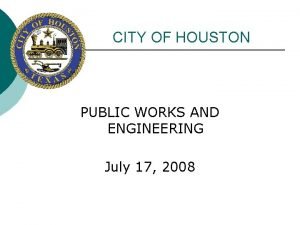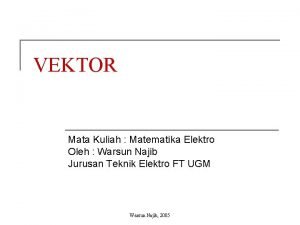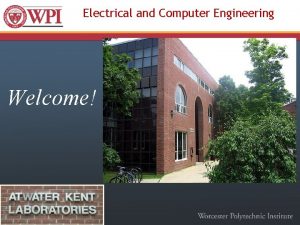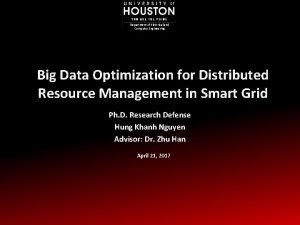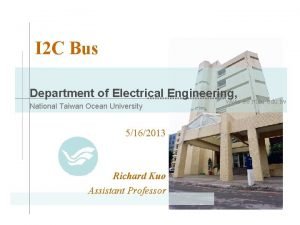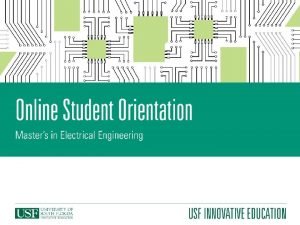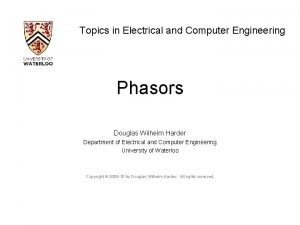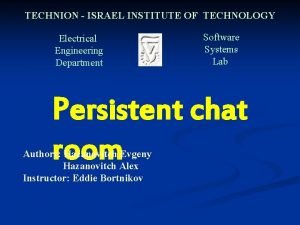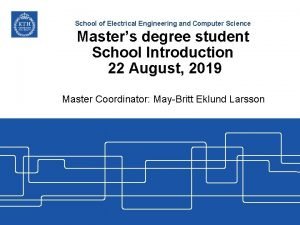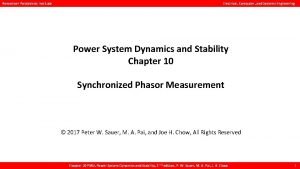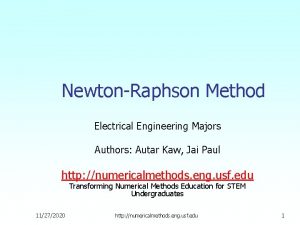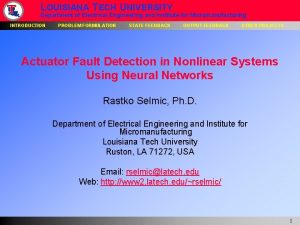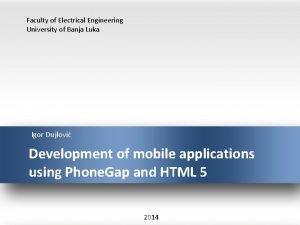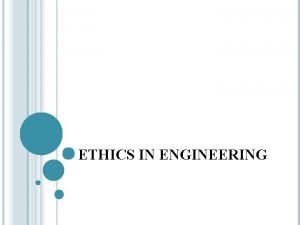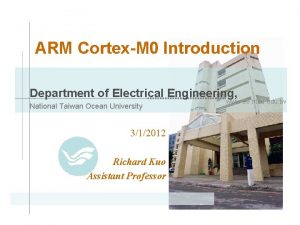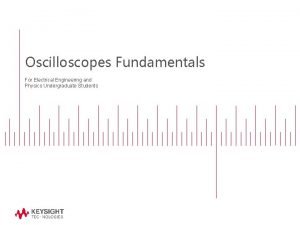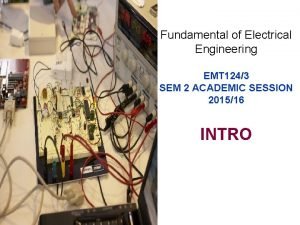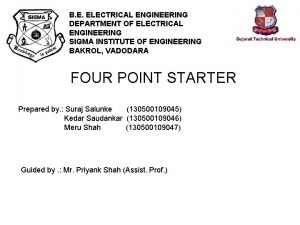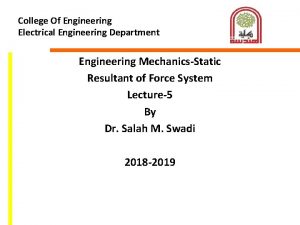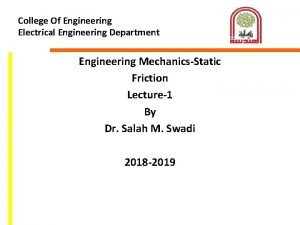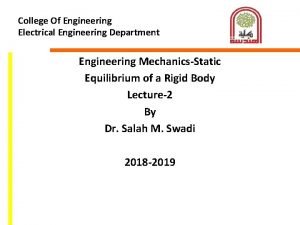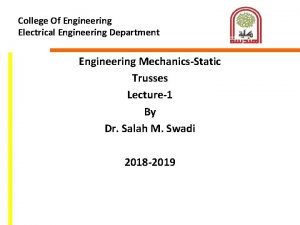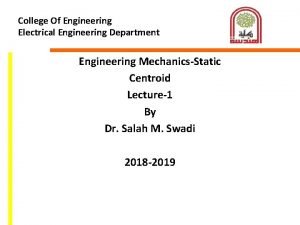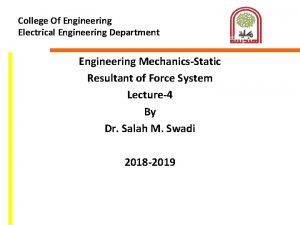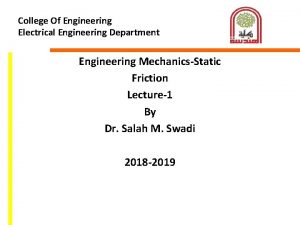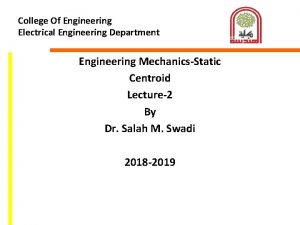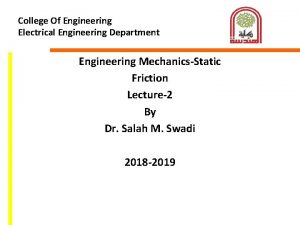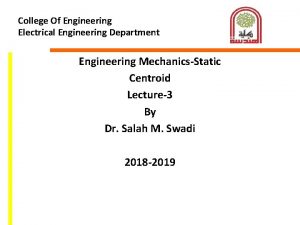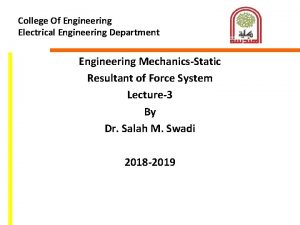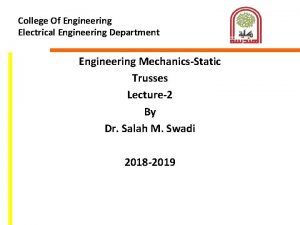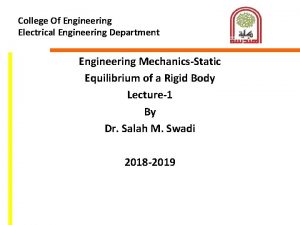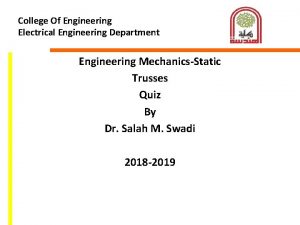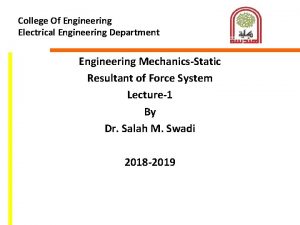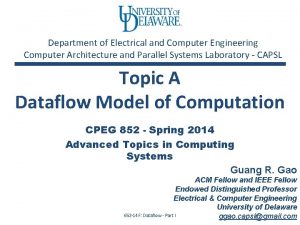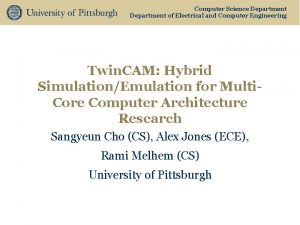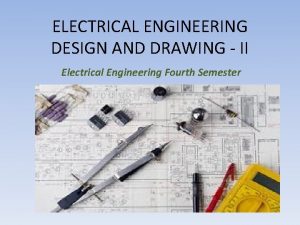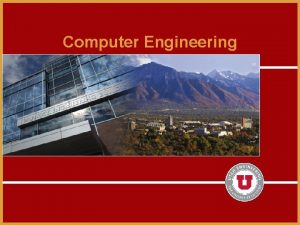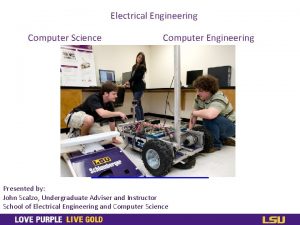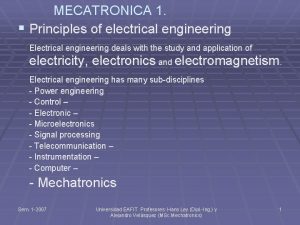Department of Electrical and Computer Engineering An Introduction











































- Slides: 43

Department of Electrical and Computer Engineering An Introduction of Stochastic Network Calculus Xuefang Liu School of Telecommunications Engineering , Xidian University Xi’an , China Feb. 2017

Department of Electrical and Computer Engineering Outline Ø What’s Network Calculus Ø Qos in Network Ø Math theory Ø Service curves & Arrival curve Ø What’s Stochastic Network Calculus Ø Examples and Focus 2

Department of Electrical and Computer Engineering Queue System Processing time is too long. How long will it take? Wait or not? The answers often serve as basis for the decisions we make 3

Queueing Theory Department of Electrical and Computer Engineering p General queueing system Arrivals Output Buffer Service Ø Queueing theory helps in planning and analyzing a system's performance guaranteens for worst-case view? 4

Department of Electrical and Computer Engineering Network Calculus u. R. Cruz. lay the foundation of Network Calculus. [1]R. L. Cruz. A calculus for network delay, Part I: Network elements in isolation. IEEE Transactions on Information Theory, 37(1): 114 -131, January 1991. [2] R. L. Cruz. A calculus for network delay, Part II: Network analysis. IEEE Transactions on Information Theory, 37(1): 132 -141, January 1991. u Goal: (1) A theoretical framework to analyze performance guarantees (maximum delays, maximum buffer space requirements…) in network. ; (2) Transform complex non-linear network systems into analytically tractable linear systems. 5

Department of Electrical and Computer Engineering Network Calculus Ø Deterministic Network Calculus (DNC) uprovide deterministic service guarantee that all packets of a flow arrive at the destination within its required performance (as throughput, delay, and loss bounds). u. Provides the highest Qo. S level. u. Drawback---must reserve network resources based on the worst-case scenario and hence leaves a significant portion of network resources unused. 6

Department of Electrical and Computer Engineering Network Calculus Ø Stochastic Network Calculus (SNC) u. Provide stochastic service guarantee that allows the Qo. S to be guaranteed with a probability. u. Allowing some packets to violate the required Qo. S measures. u. Advantage—better exploit the statistical multiplexing gain at network links and hence improve network utilization. 7

Qo. S Department of Electrical and Computer Engineering Ø Cumulative function describe the data flow as the number of bits in time interval. A 1(t) A 2(t) A 3(t) 8

Department of Electrical and Computer Engineering Qo. S---Backlog Definition: For a lossless system • The amount of bits that are held inside the system. vertical deviation between input and output functions 9

Department of Electrical and Computer Engineering Qo. S ---Delay • the delay that would be experienced by a bit arriving at time t if all bits received before it are served. Horizontal deviation 10

Department of Electrical and Computer Engineering Mathematical basis for NC Four network operations----reduce the complexity Wide-sense increasing function Min-plus algebra

Department of Electrical and Computer Engineering Ex: Why use convolution l Scenario Service element has constant service rate u l Assumption No data is lost or produced inside the service element l Backlog New arrivals Processed data Backlog at time t Service curve 12

Department of Electrical and Computer Engineering Service curve The service curve connects the convolution operator with a minimum guarantee on the service. 13

Department of Electrical and Computer Engineering Arrival curve the deconvolution operator is connected with a maximal bound on the arrivals. If arrivals were unbounded, one could immediately (and innitely) overload the system. restricts the amount of arrivals on each interval of length t. 14

Department of Electrical and Computer Engineering use the network operation Concatenation-Theorem the whole system has the service curve

Output bound Department of Electrical and Computer Engineering § Assume that a service element offers a service curve U for an input flow . § The output flow is bounded as

Department of Electrical and Computer Engineering Multiplexing Two flows with arrival curves are multiplexed into a single one. 17

Department of Electrical and Computer Engineering Leftover service curve • a strict priority scheduling scenario • For the incoming flows , their priorities are sorted by their index i. • the service element provides a strict service curve U for the aggregate

Department of Electrical and Computer Engineering Networks as Labeled Graphs 19

Department of Electrical and Computer Engineering use network operations Transform the graph to a single labeled node with a single labeled edge. 20

Department of Electrical and Computer Engineering Example: Reduce the network Orginal graph end-to-end behavior of the system the behavior at the service element V. 21

Department of Electrical and Computer Engineering Performance Bounds Considering an input flow A with arrival curve α entering a service element with service curve U. performance bounds : the maximal vertical and horizontal distance 22

Department of Electrical and Computer Engineering SNC-- Stochastic Network Calculus Motivation of SNC: when the worst case is defined by an event that is possible, yet not very likely, DNC has the problem. Solution: bounds can be broken, but only with (very) small probabilities. Difficult to get the bound Category: two SNC description which differ in how stochastic processes are described: l Tail-bounds cut off unwanted (and unlikely) outcomes , l Moment Generating Functions (MGF) are a compact way to describe a distribution as a whole. 23

Department of Electrical and Computer Engineering Tailbounded Network Calculus Ø main idea : define an arrival curve that can be broken by a given probability. Ø Two new functions: envelope function, error function. 24

Department of Electrical and Computer Engineering Tailbounded Arrival curve burst 25

Department of Electrical and Computer Engineering Tailbounded Service curve Defininition: Consider An input-output pair A and B and a service element. The service element provide tail-bounded service curve U with error function ζ, if for all t, it holds

Department of Electrical and Computer Engineering Tailbounded Network Calculus Multiplexing Subtraction Deconvolution

Department of Electrical and Computer Engineering Performance Bounds Consider the arrivals: A with arrive curve α(t, ɛ) Consider the service element: service curve (U, ζ). for all t ≥ 0 and ε > 0 , the performance bounds

Department of Electrical and Computer Engineering Application in power communication Flows are classified into different sets according to their Qo. S demands Yang Zhou, Li Yu, Juhong Tian, Chao Luo, “Stochastic Delay Analysis of Multi-services in Power Communication Networks”, International Journal of Computer and Communication Engineering, Volume 5, Number 6, November 2016

Department of Electrical and Computer Engineering Application in power communication Check the pre-negotiated policies of flow, if not, packets of the flow will be discarded

Department of Electrical and Computer Engineering Application in power communication If overload, some packets will be droped

Department of Electrical and Computer Engineering Application in power communication Core mechanisms to provide Qo. S guarantees, enable different flow to get service with different level

Department of Electrical and Computer Engineering Application in power communication Optimize or guarantee performance, improve latency, increase usable bandwidth for some kinds of packets

Department of Electrical and Computer Engineering Application in power communication Focus on the impacts of different scheduling on the performance Three typical traffics with different Qo. S guarantees: voice service (denoted by A), real-time data service (B) , monitoring service (C) Three scheduling policy: FIFO, Priority queueing , Custom queueing

Department of Electrical and Computer Engineering • Application in power communication

Department of Electrical and Computer Engineering Application in power communication • FIFO According to the aggregation property, combined service satisfies

Department of Electrical and Computer Engineering • Priority Queueing scheduling

Department of Electrical and Computer Engineering • Priority Queueing scheduling

Department of Electrical and Computer Engineering

Department of Electrical and Computer Engineering Assumption: the arrival processes of A, B, C follow Poisson distributions, and service curve is a constant rate. 40

Department of Electrical and Computer Engineering What’s the focus • Network , traffic (arrival model), service (service model) Performnce Resource Allocation Schedule policy ……… 41

Department of Electrical and Computer Engineering Reference • J-Y Le Boudec and P. Thiran, Network calculus, Springer , 2001 • Yuming Jiang, Yong Liu, Stochastic Network Calculus, Springer, 2008 • Michael Beck, Advances in Theory and Applicability of Stochastic Network Calculus, [D], the University of Kaiserslautern, 2016 42

Department of Electrical and Computer Engineering Q&A Thank You! Xuefang Liu xfliu 325@gmail. com xfliu 1@mail. xidian. edu. cn Wireless Networking, Signal Processing and Security Lab Department of Electrical and Computer Engineering University of Houston, TX, USA
 Tum department of electrical and computer engineering
Tum department of electrical and computer engineering Electrical engineering department
Electrical engineering department Ucla ee department
Ucla ee department Klipsch school of electrical and computer engineering
Klipsch school of electrical and computer engineering Computer engineering department
Computer engineering department What is system in software engineering
What is system in software engineering Open wiring design
Open wiring design Ts-2di
Ts-2di Principles and applications of electrical engineering
Principles and applications of electrical engineering Pearson engineering
Pearson engineering City of houston idm
City of houston idm Department of materials science and engineering iit delhi
Department of materials science and engineering iit delhi Vector electrical engineering
Vector electrical engineering Gwu electrical engineering
Gwu electrical engineering Tel aviv university electrical engineering
Tel aviv university electrical engineering Northwestern university computer engineering
Northwestern university computer engineering Electrical engineering umd
Electrical engineering umd Electrical engineering environmental issues
Electrical engineering environmental issues Wpi ece tracking sheet
Wpi ece tracking sheet Electrical engineering presentation
Electrical engineering presentation Kfupm ee faculty
Kfupm ee faculty Big data in electrical engineering
Big data in electrical engineering Chapter 11 electrical engineering
Chapter 11 electrical engineering Basic electrical engineering kulshreshtha
Basic electrical engineering kulshreshtha University of belgrade school of electrical engineering
University of belgrade school of electrical engineering Electrical engineering notation
Electrical engineering notation Ntou ee
Ntou ee Electrical engineering definition
Electrical engineering definition Clemson ece
Clemson ece Usf electrical engineering faculty
Usf electrical engineering faculty Phasors electrical engineering
Phasors electrical engineering Electrical engineering technion
Electrical engineering technion Lina lehn
Lina lehn Rensselaer polytechnic institute electrical engineering
Rensselaer polytechnic institute electrical engineering Newton raphson method electrical engineering
Newton raphson method electrical engineering La tech electrical engineering
La tech electrical engineering Etfbl
Etfbl Larom case
Larom case Electrical engineering fundamentals (66712)
Electrical engineering fundamentals (66712) Uh electrical engineering flowchart
Uh electrical engineering flowchart Electrical engineering roadmap
Electrical engineering roadmap Tel aviv university electrical engineering
Tel aviv university electrical engineering Oscilloscope theory
Oscilloscope theory Emt subject in engineering
Emt subject in engineering




